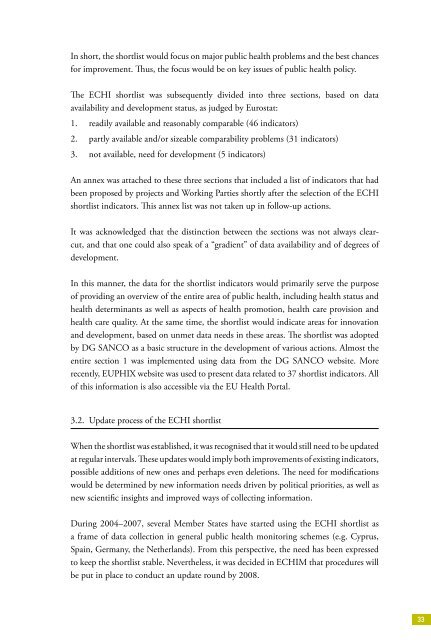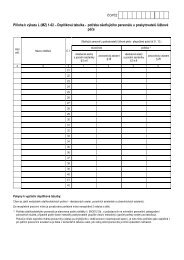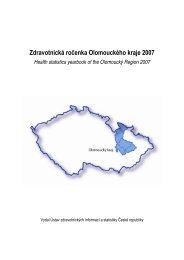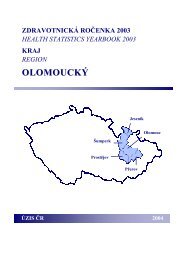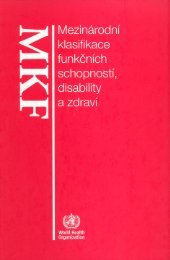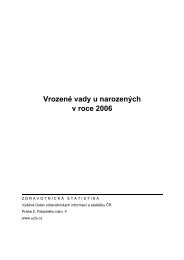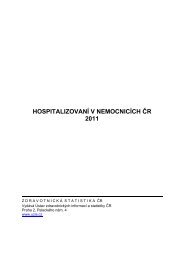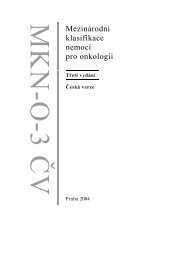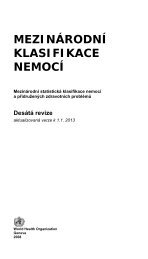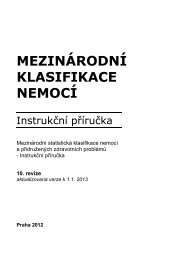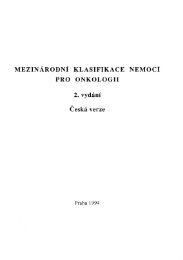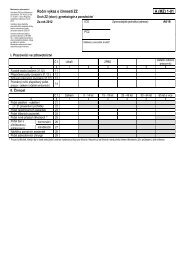ECHIM Final Report
ECHIM Final Report
ECHIM Final Report
You also want an ePaper? Increase the reach of your titles
YUMPU automatically turns print PDFs into web optimized ePapers that Google loves.
In short, the shortlist would focus on major public health problems and the best chances<br />
for improvement. Thus, the focus would be on key issues of public health policy.<br />
The ECHI shortlist was subsequently divided into three sections, based on data<br />
availability and development status, as judged by Eurostat:<br />
1. readily available and reasonably comparable (46 indicators)<br />
2. partly available and/or sizeable comparability problems (31 indicators)<br />
3. not available, need for development (5 indicators)<br />
An annex was attached to these three sections that included a list of indicators that had<br />
been proposed by projects and Working Parties shortly after the selection of the ECHI<br />
shortlist indicators. This annex list was not taken up in follow-up actions.<br />
It was acknowledged that the distinction between the sections was not always clearcut,<br />
and that one could also speak of a “gradient” of data availability and of degrees of<br />
development.<br />
In this manner, the data for the shortlist indicators would primarily serve the purpose<br />
of providing an overview of the entire area of public health, including health status and<br />
health determinants as well as aspects of health promotion, health care provision and<br />
health care quality. At the same time, the shortlist would indicate areas for innovation<br />
and development, based on unmet data needs in these areas. The shortlist was adopted<br />
by DG SANCO as a basic structure in the development of various actions. Almost the<br />
entire section 1 was implemented using data from the DG SANCO website. More<br />
recently, EUPHIX website was used to present data related to 37 shortlist indicators. All<br />
of this information is also accessible via the EU Health Portal.<br />
3.2. Update process of the ECHI shortlist<br />
When the shortlist was established, it was recognised that it would still need to be updated<br />
at regular intervals. These updates would imply both improvements of existing indicators,<br />
possible additions of new ones and perhaps even deletions. The need for modifications<br />
would be determined by new information needs driven by political priorities, as well as<br />
new scientific insights and improved ways of collecting information.<br />
During 2004–2007, several Member States have started using the ECHI shortlist as<br />
a frame of data collection in general public health monitoring schemes (e.g. Cyprus,<br />
Spain, Germany, the Netherlands). From this perspective, the need has been expressed<br />
to keep the shortlist stable. Nevertheless, it was decided in <strong>ECHIM</strong> that procedures will<br />
be put in place to conduct an update round by 2008.<br />
33


